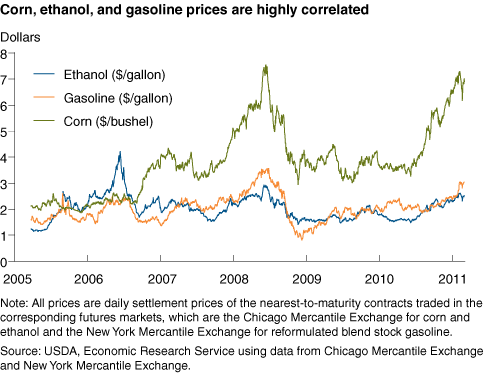Ethanol Strengthens the Link Between Agriculture and Energy Markets
- by Lihong McPhail and Xiaodong Du
- 6/5/2012
The growing role of the ethanol industry as a supplier to the U.S. motor fuels market has reshaped the relationship between agriculture and energy markets. Historically, the correlation between agricultural prices and energy prices was weak and primarily reflected the role of energy as an input in agricultural production. However, the growing use of corn to produce energy has strengthened the link between these two markets. A recent study by an ERS economist found that price relationships between the U.S. corn and gasoline markets strengthened significantly after March 2008 and continue to be highly correlated. From March 2008 to March 2011, ethanol supply and demand accounted for about 23 percent of the variation in the price of corn, while corn market conditions accounted for about 27 percent of ethanol's price variation. At the same time, about 16 and 17 percent of gasoline price variation can be attributed to shocks to ethanol and corn markets, respectively. The impacts of corn and ethanol prices on gasoline price volatility are surprisingly large given that ethanol is only a small portion of the overall energy market. The related price dynamics and market adjustment warrant further study.
With the growing share of corn used in ethanol production, the corn market is increasingly exposed to demand-side shifts in the petroleum market based on ethanol's role as a gasoline substitute. U.S. corn-based ethanol production was 13.2 billion gallons in 2010, accounting for almost 40 percent of total U.S. corn use in the 2010 crop year. In the same period, ethanol was blended into over 90 percent of the Nation's gasoline supply, replacing about 445 million barrels of imported oil. As gasoline prices rise, ethanol's appeal as a blend increases as does the profitability of ethanol production and the demand for corn.
While the agriculture and energy markets become more closely correlated, so, too, does the degree of price volatility between these markets. Energy markets are notoriously volatile, and this effect can now more easily pass onto agricultural commodity markets.
This article is drawn from:
- 'Inside the Black Box: The Price Linkage and Transmission Between Energy and Agricultural Markets'. (2012). Energy Journal. 'Inside the Black Box: The Price Linkage and Transmission Between Energy and Agricultural Markets,' by Xiaodong Du and Lihong Lu McPhail, in Energy Journal, Vol. 33, No. 2, 2012, pp. 171-194..


